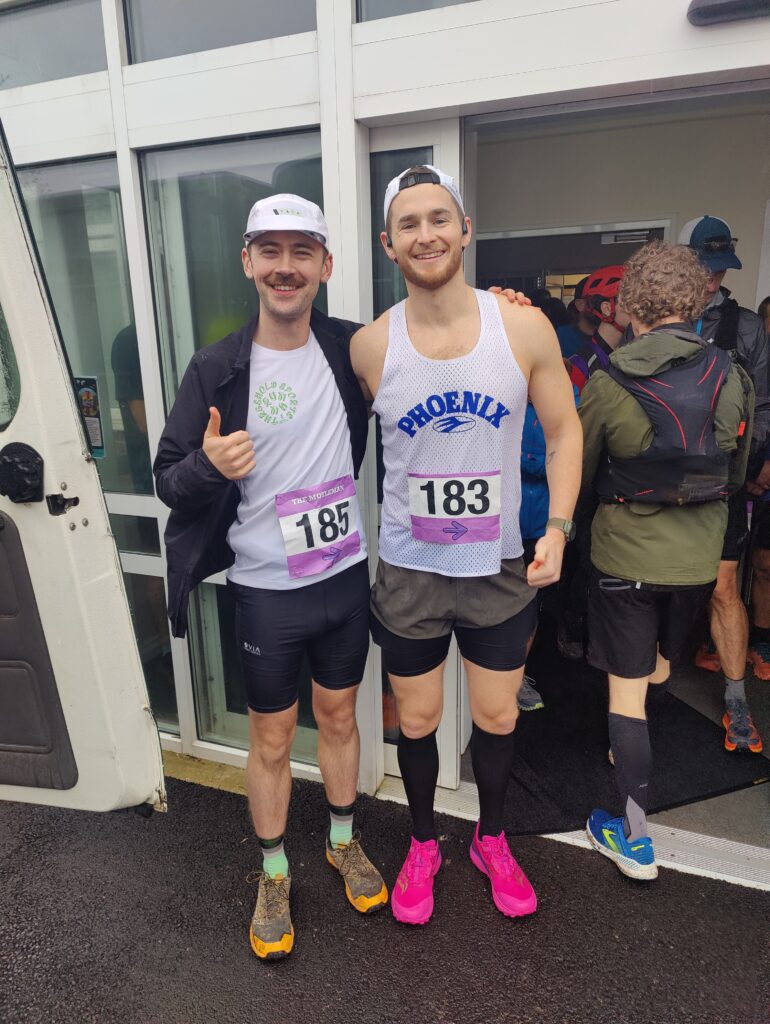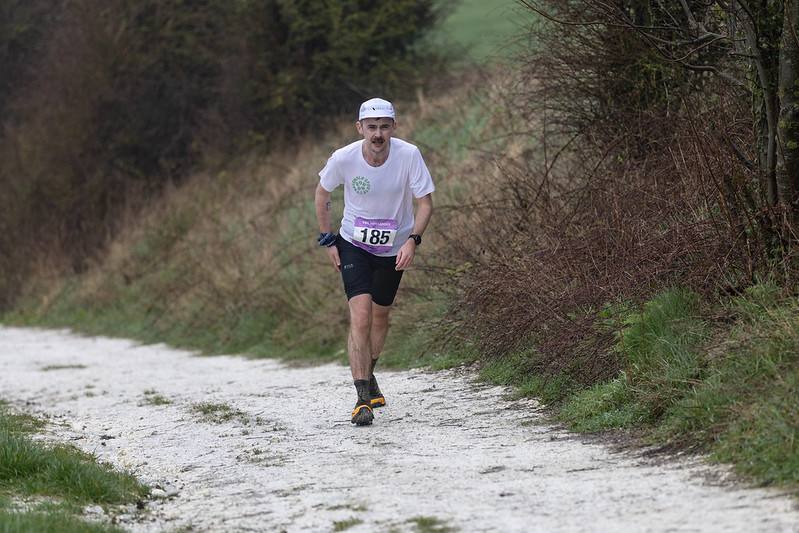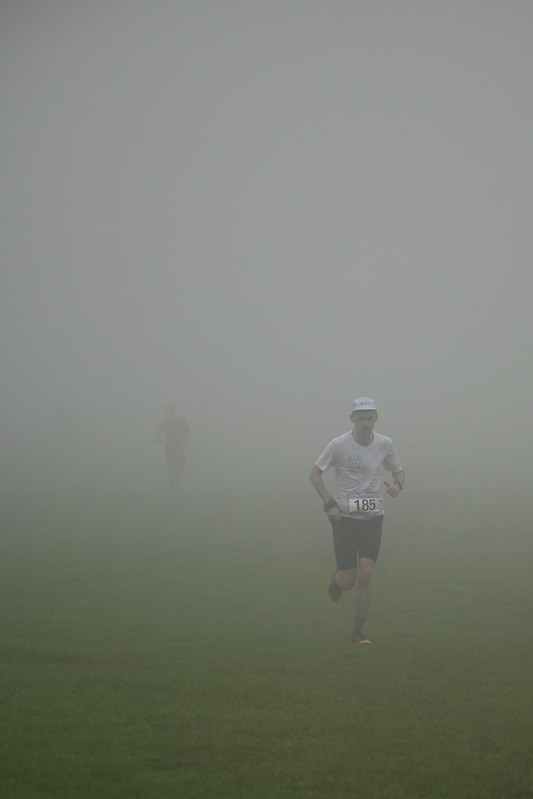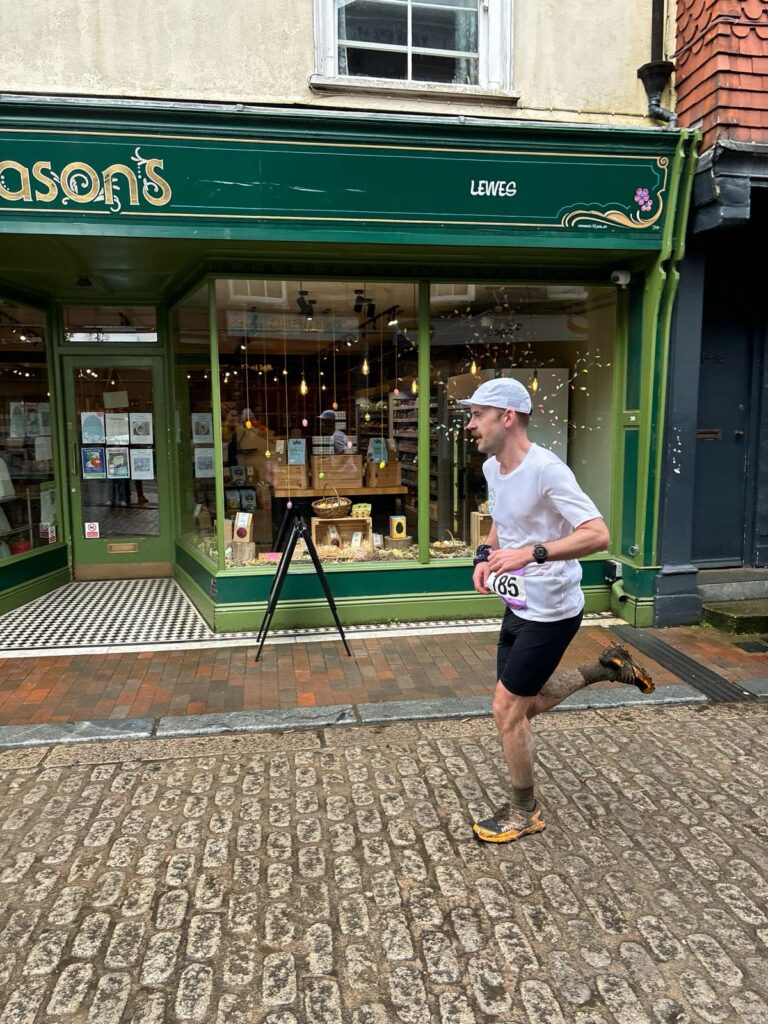The Moyleman
Posted by Ed on March 21, 2024
The Moyleman is a marathon-distance hill race taking place each March in Lewes, East Sussex. Taking in around 1000m of climbing, the course consists of a single loop around the South Downs, ticking off (or at least passing by) the summits of Black Cap, Firle Beacon, and Mount Caburn, as well as an extended jaunt up, along, down, back up again, and finally back down Kingston Ridge.
The race itself is extremely low-key. Organised entirely by volunteers in tribute to the late Chris Moyle, a Lewes-based running legend, it is extremely popular with locals (this year it sold out in 15 minutes) but largely unknown to outsiders. This lends it the feel of a grassroots fell race, the likes of which you typically only find further north.
Another thing you might expect to only find further north are hills. But whilst they are dwarfed by the fells and mountains further north in Britain, the South Downs are no mere hillocks. Rising from sea level to 270m (890 feet) or so at their highest, they describe a southeasterly/northwesterly line across the South of England, building up from Winchester in the West before dramatically plummeting into the sea just outside Eastbourne. Their defining feature (aside from the chalk) is the way in which they undulate – whereas the ascent of a Lake District fell or Scottish mountain is defined by a heart-stopping climb straight to the summit, the Downs spread their elevation over many miles. This makes them arguably the perfect terrain for my favourite kind of race: properly hilly, but also largely runnable.
My goals for this race were quite simple. Ever since my name was called, substantially against the odds, in the Western States lottery, I have poured all my spare psychological energy into preparing for that race. This meant the first 11 weeks of 2024 were spent focusing on building a solid base.

Across those eleven weeks, I ran 650km and climbed just shy of 6000m. Not a colossal amount, but more than I’ve ever done this far out from a goal race. At no point in those eleven weeks did I run more than 85km a week, and (very much unlike previous training blocks) I did not tick off any long runs over 28km. Instead, I prioritised mid-week volume, week-on-week consistency, and plenty of variety, with a steady mix of Monday track sessions, pack-laden commute trots, and trail-oriented weekend long runs.
The result was that, standing on the start line for the Moyleman having tapered quite aggressively, I felt like a coiled spring. I had high hopes of potentially landing a spot in the top ten. But really, knowing the calibre of athletes toeing the line, all I cared about was executing a solid race and walking away feeling like the first portion of my Western States training had made some kind of a difference to my fitness.
The Race
Like any good race, the Moyleman starts uphill with a gradual ascent of Blackcap. Quite quickly I found myself near the front of the pack, which momentarily did make me wonder if I was going out too hard. But reflecting on all the hours I’ve spent trotting up the Norwood Ridge with a fully laden pack (laptop and all) on my run commutes, it stood to reason that I would be strong on the ascents, so I opted to go with my gut and run what felt right.
As we neared the top of the first climb, I caught up with my friend and colleague Alex, who first alerted me to the race and encouraged me to enter last Autumn. Alex is a monster of an athlete and a cut above me in the strange and confusing world of road running, and I must admit I felt a pang of anxiety around overtaking him. But I also knew he was dealing with a bit of a hip niggle, and is taking on Brighton marathon in a few short weeks. Again, going against my instinct to downplay my own ability, I pressed on and left Alex behind, wondering if and when he might catch me later on the race.
It’s at this point I should mention a major advantage I had secured myself for this race – my choice of shoe. In the weeks before race day, the South of England had been subjected to the kind of consistent downpour that leaves the ground completely saturated with water. The Downs, being made up of chalk, normally drain very well – twice I have run the South Downs Way 50 in early April (in 2021 and 2023) and twice I have enjoyed pristine conditions underfoot. In previous years the Moyleman, a March race, has been won by athletes wearing carbon-plated road shoes.
This year, however, things couldn’t have been more different. ‘Wet’ simply doesn’t cover it. I have never, in my seven years of running, taken part in an event in which there was that much mud and standing water to contend with. It was simply non-stop. The weather itself, whilst drizzly to begin with and very misty throughout, was not so bad (indeed, I ran the whole thing in just a t-shirt and shorts). But the conditions underfoot were frankly biblical. It’s for this reason that I was so incredibly glad to have opted to run in my Inov-8 X-Talon Ultras. These unbeatably grippy shoes are designed for tackling terrain like that encountered on the Spine, and as such are capable of withstanding even the squelchiest of conditions. As I swept down the waterlogged farm-track descent from Blackcap, I felt incredibly sure of my footing, and was able to maintain a pace that kept in contention for the podium early on.

First place, by this point, had vanished from view. But I danced between second and fourth with two other runners. As we made our way up the short, steep woodland section and down the knee-knocking descent towards Housedean Farm and the first checkpoint, I made sure to have a few honest words with myself. Things were just going too well, and I wanted to be sure I wasn’t overdoing it. But I honestly felt like I was pushing at an effort appropriate to the task at hand, so all there was to do was continue and see where the cards might fall.
After the road crossing at Housedean myself and my companions spotted the runner in first place up ahead. Whether he had eased up deliberately or was otherwise struggling we couldn’t be sure, but it definitely gave us a surge of adrenaline as we picked our way along the endless climb up Kingston Ridge. As we ascended, my mind flashed back to this same stretch of trail last June, 16 hours and 70-odd miles into the South Downs Way 100 in very, very different conditions. I remember vividly my pacer Mark reading messages of support from our WhatsApp group, including a goodnight message from my mum. It was at that point that I realised how tired I was.
My revery was interrupted by the Moyleman’s first deviation from the South Downs Way since joining it a few miles into the race. Rather than following the line of the ridge, the route dishes out a punishing descent on hard-packed ground and through a neighbouring valley. It was here that we finally caught up with and overtook the runner in first, who, it was now clear, was struggling with some kind of injury (I later learned he dropped out of the race.)
Now running in joint first place with a pack-clad runner in blue, I once again had to remind myself to stay comfortable. Knowing that it was ours to lose, we both eased up a little bit and almost ran as a team, which I was grateful for, as the lack of footfall to this part of the course was immediately evident. Where there once, presumably, was a path, we found ourselves running across a freshly ploughed field, our feet growing heavier with every step. Ankle-deep puddles and mud-soaked cambers certainly put a dent in our pace, but the drier chalk trail soon returned and we climbed back up on the ridgeline, a mountain biker up ahead showing us the way.
Once the trail hardened out I struggled to keep up with my pack-clad companion, and on the punishingly long, punishingly straight ‘yellow brick road’ descent into Southease I was caught by one of the pack we had left behind. But I didn’t let this bother me – it was clear by now just how much of an advantage I had on the sloppy stuff, so the fact that I had lost ground on a long, runnable descent didn’t really come as a surprise.

After the treacherous descent into the farm just outside Southease I had a rare clear view up ahead (the mist had, for the most part, made it impossible to see how far ahead or behind I was from any competitors.) Whilst both runners in front had managed to put down a reasonable lead, I was glad to note that the runner behind me was nowhere to be seen, even as I left the track and looked back from atop the short, steep climb that follows.
Coming into Southease, and the halfway point, then, was a real highlight. For one thing, simply running on a road and not a puddle-dappled trail of slop was a massive relief, and I felt like I was flying. But it was the incredible supporters and volunteers that really made the difference. The cheers I got as the third runner to appear were colossal, and it was truly thrilling to feel celebrated as a competitive runner at the sharp end of a race.
I made quick work of the water station, my only planned stopping point. I filled a pre-loaded bottle of Tailwind, grabbed a gel, and carried on my way, bounding with a newfound pep thanks to the supporting crowd.

The ascent to Firle Beacon was, as always, a real slog. Whilst the worst of the climbing is over within a kilometre and a half, the full ascent is closer to 6k in length, meaning for 30-odd minutes you’re just grinding uphill. But, whilst I felt like I was making slow progress, I was pleasantly surprised to catch up with and ultimately overtake the runner in second place, who seemed to be flagging somewhat. This gave me a bit of a boost as I rolled my way up the remainder of the climb, until I was caught by a runner I’d not seen before who was so full of beans I initially thought he must be the leader of the relay half-marathon event that started 15 minutes after the marathon. Carrying little more than a Lucozade bottle, he bounded past me and by the time we’d exchanged brief pleasantries he had vanished into the mist.
Back again, then, in third, I made my way through a featureless landscape of mist and grass, the path barely discernible but easy enough to follow thanks to its intuitive flow. It wasn’t long before I reached the sharp turn which signifies the end of the Moyleman’s dance with the South Downs Way – a steep road descent into the valley, on which I was caught by not one but two runners, both flowing along quite happily conversing whilst I died a small death trying to keep pace.
Having dropped from second to fifth in the space of a few kilometres, and with 16km still to go in the race, it was at this point that my heart started to sink. Typically I am a conservative, strategic runner – I like to sit back, stay comfortable, before surging and gaining ground in the second half of a race. But at the Moyleman, for whatever reason, I’d gone out strong and opted to ‘see what happens’. What appeared to be happening, however, was a slow and unstoppable fade.

Or so I thought. Over the next few miles of runnable (though puddle-dappled) roads and farm tracks, I struggled to hold a decent pace, my legs blown out and unresponsive after dancing about on hills and mud for a few hours. But, despite my frustration – and my conviction that a hoard of vest-clad runners were about to stampede past me – nobody appeared over my shoulder, save for a couple of half marathon relay runners looking fresh as a daisy.
This remained the case for the rest of the event. As we passed through Glynde and across a waterlogged field (honestly, more of a marsh), I got a rare glimpse of the route behind me, mist-free and stretching back at least half a kilometre. No other marathon runners were in sight. Thus, grinding my way the absolute monster that is Mount Caburn in the final 3km of the race, I was finally able to accept that I was possibly going to finish in fifth place – not a podium, alas, but nonetheless a great position in a decently-contested race.

I exchanged a few words with a half marathon relay runner on the climb. She was in second place in her event, and had a healthy lead on third, who also caught me at the bottom of the flying descent. After one final roller up and out of the valley, the route turned to tarmac and dropped steeply back into Lewes, hitting a 17+% gradient in the process. I did all I could to fling myself down it, though by this point my legs were pretty much shot.
Turning the corner into Lewes high street, supporters clapped and cheered and I finally crossed the finish line at Harvey’s brewery in 3:38 and change, 10 minutes behind the pack-clad runner I had spent the first part of the race with who eventually finished first. It’s a testament to this year’s challenging conditions that his winning time of 3:28 would, in previous years, barely have got him a spot in the top ten!
Closing Thoughts
The Moyleman has no medals – a pint glass and a free pizza are your only material rewards.
But what the event lacks in flashy goodies it more than makes up for in heart and soul. I would highly recommend this event to anyone who wants to experience a truly gritty, grassroots trail race in the South that doesn’t skimp on hills. As a season opener, it was the perfect event to springboard my way into another block of Western States training.
Up next: the Chiltern Ridge 50k in April, where I plan to race a tad more conservatively, but nonetheless go for broke.
